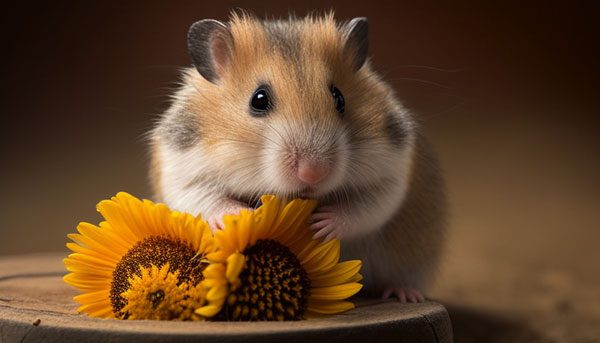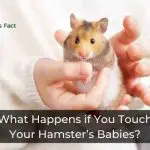Hamster With Down Syndrome – Why Is It Not What It Looks?
Is your hamster showing signs of Down Syndrome? And is it even possible for hamsters to have Down Syndrome in the first place? As per general consensus, a hamster is unlikely to develop this genetic disorder.
Hamster with down syndrome – why is it not what it looks? Though the physical facial structure of certain hamsters may differ, it is not indicative of Down Syndrome. In fact, it is most likely a craniofacial abnormality due to poor breeding practices. Down syndrome is caused by an extra copy of chromosome 21, which is not found in the genetic makeup of hamsters.
Read more to find out why hamsters can’t have Down Syndrome. Also, find out what might be the issue and why it’s often mistaken for Down Syndrome.
Hamster With Down Syndrome – Why Is It Not What It Looks?
There is no such thing as a hamster with Down syndrome. Human beings are the only known species to experience Down Syndrome, a genetic abnormality that has no bearing on other species, such as hamsters.

However, some hamsters may have physical or behavioral abnormalities, but these are usually due to other causes. Nevertheless, hamsters are sometimes mistaken to have down syndrome because of
Facial features
While hamsters may appear to have facial features resembling Down Syndrome characteristics, this is not the case.
The facial shape in some hamsters results from craniofacial abnormality, which is common due to poor breeding practices.
In fact, most hamsters are bred specifically for their distinctive physical features, such as large, round cheeks. These characteristics are desirable in the pet trade and have been selectively bred over generations to create the perfect pet hamster.
Congenital issues
It is worth emphasizing that the cause of craniofacial deformities in hamsters can be attributed to multiple factors, not exclusively poor breeding. In addition, there are many other reasons why a hamster’s face might look different from normal, such as aging or congenital issues.
For instance, Hamsters can develop conditions such as Microphthalmia. This is a congenital defect where the eyes are smaller than normal or absent altogether. This condition can lead to blindness or visual impairment.
Therefore, it is best to research and take your hamster to the vet for a proper diagnosis if you suspect something is wrong with your hamster.
Why Hamsters Cannot Have Down Syndrome
Down Syndrome is a chromosomal disorder caused an extra copy of chromosome 21. This genetic condition affects humans, and there is no evidence to suggest that hamsters can have Down Syndrome.
Although hamsters and humans share some similarities in physiology and anatomy, hamsters are fundamentally different animals, and their genetics are incompatible.

Unlike humans, hamsters have a different number of chromosomes. For example, Syrian hamsters have 44 chromosomes, while dwarf hamsters have 34 chromosomes.
In both cases, this is significantly different from the 46 chromosomes that humans have. This means that the genetic mechanisms that cause Down Syndrome in humans are simply not present in hamsters.
What Craniofacial Abnormality Looks Like
Craniofacial abnormalities in hamsters can manifest in various ways, ranging from mild to severe. Some of the most common abnormalities that can be observed include
- A misshapen skull
- Shortened or elongated snout
- Misaligned teeth
- Asymmetrical facial features
- One common example of a craniofacial abnormality in hamsters is Brachygnathia, which is characterized by an abnormally short lower jaw. This condition can cause problems with eating and drinking and may also lead to tooth misalignment, as the teeth may not line up properly.
- Another example is prognathism, where the lower jaw is elongated, causing difficulty in properly closing the mouth.
- In addition, hamsters may develop nasal deformities, such as cleft palate. This condition causes the roof of the mouth to fail to close completely during development, leading to an opening between the nasal cavity and the mouth.

In some cases, craniofacial abnormalities in hamsters may not be immediately apparent and may only be detected through X-rays or other imaging techniques.
These abnormalities may not necessarily cause any overt symptoms or health problems. However, they may still impact the animal’s overall well-being.
What Causes Craniofacial Abnormality?
Several factors can contribute to the development of craniofacial abnormalities in hamsters. These include
- Genetics
- Inbreeding
- Environmental factors
- Nutrition
Common genes associated with craniofacial abnormalities in hamsters include the FGF8 and Eda genes.

These genes are involved in the development of the facial skeleton and teeth, and mutations in these genes can lead to a wide range of craniofacial abnormalities.
In some cases, craniofacial abnormalities can lead to health problems, such as difficulty eating or breathing. If this is the situation, you need to give your hamster mushy food and talk to the vet about its diet since it cannot consume anything solid.
If you’re interested in learning more about hamster health, you may want to check out our articles on how long hamsters can go without water and why your hamster may be breathing fast. Our article on how long hamsters can go without water explains how to keep your hamster hydrated and the signs of dehydration to look out for. Meanwhile, our article on why your hamster may be breathing fast discusses the possible reasons behind this behavior and what you can do to help your hamsterFAQs
We’ll answer common questions about hamsters and Down Syndrome in this section.
Q. Can a hamster have Down Syndrome?
No. A hamster cannot have Down Syndrome. It can only develop genetic mutations or abnormalities resembling Down Syndrome, such as craniofacial abnormalities.
Q. Why can’t hamsters have Down Syndrome?
Down Syndrome is caused by an extra copy of chromosome 21 in humans. Hamsters have a different number of chromosomes and do not possess a chromosome that is equivalent to human chromosome 21.
Q. What causes craniofacial abnormalities in hamsters?
Various genetic or environmental factors, including poor breeding practices, may cause craniofacial abnormalities in hamsters. The condition should be evaluated and diagnosed by a veterinarian with experience in exotic animal medicine.
Conclusion
Some hamsters may exhibit traits or behaviors that resemble those associated with Down Syndrome. However, Down Syndrome is a genetic disorder that occurs in humans, and an extra copy of chromosome 21 causes it.
Hamsters, on the other hand, have a different number of chromosomes and do not possess this specific gene mutation. Thus, Craniofacial abnormality is usually mistaken for Down Syndrome in hamsters. It can be congenital (present at birth) or acquired due to injury or disease.




